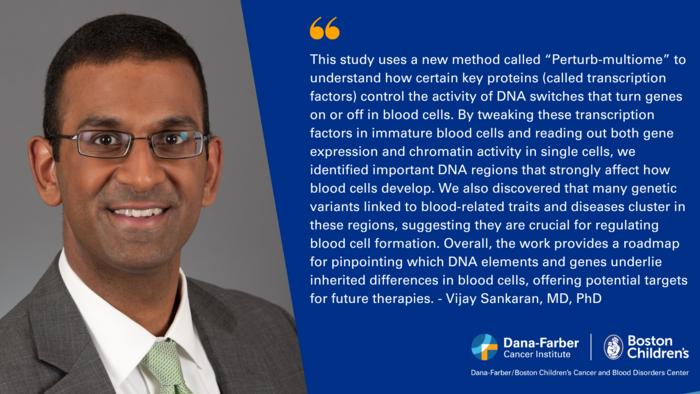
In an extraordinary advancement for the field of genetics, researchers associated with the Dana-Farber Cancer Institute have unveiled a groundbreaking tool designed to reverse-engineer genetic programming in cells. The novel genomic screening tool, dubbed “Perturb-multiome,” leverages the CRISPR technology to facilitate a more in-depth understanding of how specific proteins, known as transcription factors, dictate cellular growth and development. This innovation holds immense potential for precision medicine, particularly in treating various blood disorders.
Traditional methods of studying gene function often involve analyzing one gene at a time, which can be both time-consuming and inefficient. The Perturb-multiome approach revolutionizes this process by allowing investigators to knock out the activity of multiple transcription factors simultaneously across a vast array of blood cell types. This comprehensive strategy marks a significant leap in the way researchers can study gene-gene interactions, ultimately propelling us into a new era of genomic understanding.
By employing this state-of-the-art technique, the research team was able to perform extensive single-cell analyses to assess the outcomes of their gene editing efforts. They meticulously tracked alterations in gene expression, identifying which genes were activated, which were suppressed, and highlighting regions of the DNA that exhibited changes in accessibility due to epigenetic modifications. Such insights can elucidate the complex regulatory networks that govern cell differentiation, maturation, and overall function.
The focus of the team’s research was on immature blood cells, providing a fertile ground to explore vital transcription factors and the genomic loci they control. Through this rigorous investigation, the team discovered that certain DNA regions, although they comprise less than 0.3% of the entire human genome, exert a disproportionately large impact on the developmental trajectory of blood cells. Notably, many of these regions harbor mutations that are linked to various hematological disorders, making this discovery particularly significant for both clinical applications and basic science.
Understanding these genomic influences is paramount, especially given that previous investigations have identified key transcription factors that contribute to the regulation of fetal hemoglobin. The groundwork laid by these prior studies has implications for developing novel gene therapies targeting conditions like sickle cell disease and beta-thalassemia, which affect millions worldwide. The emergence of the Perturb-multiome tool signifies a strategic advancement, potentially unveiling a plethora of transcription factor variants that influence not only blood cell development but also the risk of associated diseases.
The research findings underscore a broader significance as well, illuminating potential pathways for targeted therapies in treating blood disorders. By systematically dissecting how transcription factors modulate gene expression and contribute to disease pathology, this research opens the door to innovative therapeutic strategies that could transform patient care within hematology and beyond.
Each innovative breakthrough in genetics and molecular biology holds the promise of improving human health outcomes. The ability of the Perturb-multiome approach to uncover intricate details within the transcription factor networks amplifies the potential for targeted research initiatives aimed at elucidating the underlying mechanisms of genetic diseases. Researchers and clinicians alike are hopeful that by harnessing these insights, they will be better equipped to develop preventive strategies and interventions that can fundamentally change the landscape of genetic disorders.
The collaborative nature of this study, involving experts from both the Dana-Farber and Boston Children’s Cancer and Blood Disorders Center, exemplifies the importance of interdisciplinary approaches in addressing complex biological questions. Team science fosters an environment where diverse expertise converges, generating innovative methodologies and fostering more comprehensive solutions to pressing medical challenges.
Moreover, the implications of this research extend beyond blood disorders; the insights gained can have far-reaching applications across various fields of genomics and personalized medicine. By refining our understanding of gene regulation through comprehensive genomic screening, scientists may uncover new targets for intervention in other diseases characterized by similar genetic underpinnings.
Funding for this groundbreaking research was generously provided by various prestigious organizations, underscoring the importance of concerted efforts in furthering scientific discovery. The collaboration of institutions such as La Caixa Foundation, the Rafael del Pino Foundation, and the American Society of Hematology demonstrates a unified commitment to advancing healthcare through scientific research. Their support is crucial in propelling forward the research agenda in areas that promise life-changing therapeutics.
In conclusion, the introduction of the Perturb-multiome tool represents a significant milestone in our quest to understand the interplay between genes and cell fate. As investigations continue to unfold, one can only anticipate the myriad of discoveries that will enrich our knowledge of genetics and ultimately translate into tangible benefits for patients grappling with blood disorders and other medical conditions influenced by genetic factors. This research cultivates hope for transformative therapies and a deeper understanding of the genetic architecture that shapes our biology.
Subject of Research: Transcription factor networks and their impact on blood cell development.
Article Title: Transcription factor networks disproportionately enrich for heritability of blood cell phenotypes.
News Publication Date: 3-Apr-2025.
Web References: https://www.science.org/doi/10.1126/science.ads7951
References: 10.1126/science.ads7951
Image Credits: Credit: Dana-Farber Cancer Institute
Keywords
Life sciences, Genetics, Developmental genetics, Scientific community, Scientific approaches, Discovery research.
Tags: blood disorder treatmentsCRISPR technology applicationsDana-Farber Cancer Institute researchepigenetic modifications in geneticsgene-gene interaction studiesgenomic screening toolinnovative gene function analysismulti-gene knockout strategiesPrecision Medicine Advancementsreverse-engineering genetic programmingsingle-cell analysis techniquestranscription factors role in cells





